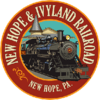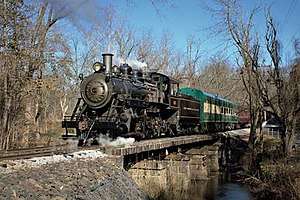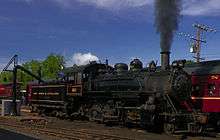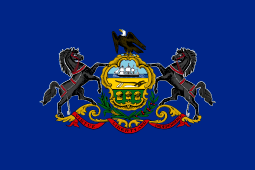New Hope and Ivyland Railroad
 | |||||||||||||||||||||||||||||||||||||||||||||||||||||||||||||||||||||||||||||||||||||||||||||||||||||||||||||||||||||||||||||||||||||||||||||||||||||||||||||||||||||||||||||||||||||||||||||||||||||||||||||||||||||||||||||||||||||||||||||||||||||||||||||||||||||||||||||||||||||||||||||||||||||||||||||||||||||||||||||||||||||||||||||||||||||||||||||||||||||||||||||||||||||||||||||||||||||||||||||||||||||||||||||||||||||||||||||||||||||||||||||||||||||||||||||||||||||||||||||||||||||||||||||||||||||||||||||||||||||||||||||||||||||||||||||||||||||||||||||||||||||||||||||||||||||||||||||||||||||||||||||||||||||||||||||||||||||||||||||||||||||||||||||||||||||||||||||||||||||||||||||||||||||||||||||||||||||||||||||||||||||||||||||||||||||||||||||||||||||||||||||||||||||||||||||||||||||||||||||
 New Hope & Ivyland 40 reversing over 2nd Ingham Run Bridge | |||||||||||||||||||||||||||||||||||||||||||||||||||||||||||||||||||||||||||||||||||||||||||||||||||||||||||||||||||||||||||||||||||||||||||||||||||||||||||||||||||||||||||||||||||||||||||||||||||||||||||||||||||||||||||||||||||||||||||||||||||||||||||||||||||||||||||||||||||||||||||||||||||||||||||||||||||||||||||||||||||||||||||||||||||||||||||||||||||||||||||||||||||||||||||||||||||||||||||||||||||||||||||||||||||||||||||||||||||||||||||||||||||||||||||||||||||||||||||||||||||||||||||||||||||||||||||||||||||||||||||||||||||||||||||||||||||||||||||||||||||||||||||||||||||||||||||||||||||||||||||||||||||||||||||||||||||||||||||||||||||||||||||||||||||||||||||||||||||||||||||||||||||||||||||||||||||||||||||||||||||||||||||||||||||||||||||||||||||||||||||||||||||||||||||||||||||||||||||||
| Reporting mark | NHRR | ||||||||||||||||||||||||||||||||||||||||||||||||||||||||||||||||||||||||||||||||||||||||||||||||||||||||||||||||||||||||||||||||||||||||||||||||||||||||||||||||||||||||||||||||||||||||||||||||||||||||||||||||||||||||||||||||||||||||||||||||||||||||||||||||||||||||||||||||||||||||||||||||||||||||||||||||||||||||||||||||||||||||||||||||||||||||||||||||||||||||||||||||||||||||||||||||||||||||||||||||||||||||||||||||||||||||||||||||||||||||||||||||||||||||||||||||||||||||||||||||||||||||||||||||||||||||||||||||||||||||||||||||||||||||||||||||||||||||||||||||||||||||||||||||||||||||||||||||||||||||||||||||||||||||||||||||||||||||||||||||||||||||||||||||||||||||||||||||||||||||||||||||||||||||||||||||||||||||||||||||||||||||||||||||||||||||||||||||||||||||||||||||||||||||||||||||||||||||||||
|---|---|---|---|---|---|---|---|---|---|---|---|---|---|---|---|---|---|---|---|---|---|---|---|---|---|---|---|---|---|---|---|---|---|---|---|---|---|---|---|---|---|---|---|---|---|---|---|---|---|---|---|---|---|---|---|---|---|---|---|---|---|---|---|---|---|---|---|---|---|---|---|---|---|---|---|---|---|---|---|---|---|---|---|---|---|---|---|---|---|---|---|---|---|---|---|---|---|---|---|---|---|---|---|---|---|---|---|---|---|---|---|---|---|---|---|---|---|---|---|---|---|---|---|---|---|---|---|---|---|---|---|---|---|---|---|---|---|---|---|---|---|---|---|---|---|---|---|---|---|---|---|---|---|---|---|---|---|---|---|---|---|---|---|---|---|---|---|---|---|---|---|---|---|---|---|---|---|---|---|---|---|---|---|---|---|---|---|---|---|---|---|---|---|---|---|---|---|---|---|---|---|---|---|---|---|---|---|---|---|---|---|---|---|---|---|---|---|---|---|---|---|---|---|---|---|---|---|---|---|---|---|---|---|---|---|---|---|---|---|---|---|---|---|---|---|---|---|---|---|---|---|---|---|---|---|---|---|---|---|---|---|---|---|---|---|---|---|---|---|---|---|---|---|---|---|---|---|---|---|---|---|---|---|---|---|---|---|---|---|---|---|---|---|---|---|---|---|---|---|---|---|---|---|---|---|---|---|---|---|---|---|---|---|---|---|---|---|---|---|---|---|---|---|---|---|---|---|---|---|---|---|---|---|---|---|---|---|---|---|---|---|---|---|---|---|---|---|---|---|---|---|---|---|---|---|---|---|---|---|---|---|---|---|---|---|---|---|---|---|---|---|---|---|---|---|---|---|---|---|---|---|---|---|---|---|---|---|---|---|---|---|---|---|---|---|---|---|---|---|---|---|---|---|---|---|---|---|---|---|---|---|---|---|---|---|---|---|---|---|---|---|---|---|---|---|---|---|---|---|---|---|---|---|---|---|---|---|---|---|---|---|---|---|---|---|---|---|---|---|---|---|---|---|---|---|---|---|---|---|---|---|---|---|---|---|---|---|---|---|---|---|---|---|---|---|---|---|---|---|---|---|---|---|---|---|---|---|---|---|---|---|---|---|---|---|---|---|---|---|---|---|---|---|---|---|---|---|---|---|---|---|---|---|---|---|---|---|---|---|---|---|---|---|---|---|---|---|---|---|---|---|---|---|---|---|---|---|---|---|---|---|---|---|---|---|---|---|---|---|---|---|---|---|---|---|---|---|---|---|---|---|---|---|---|---|---|---|---|---|---|---|---|---|---|---|---|---|---|---|---|---|---|---|---|---|---|---|---|---|---|---|---|---|---|---|---|---|---|---|---|---|---|---|---|---|---|---|---|---|---|---|---|---|---|---|---|---|---|---|---|---|---|---|---|---|---|---|---|---|---|---|---|---|---|---|---|---|---|---|---|---|---|---|---|---|---|---|---|---|---|---|---|---|---|---|---|---|---|---|---|---|---|---|---|---|---|---|---|---|---|---|---|---|---|---|---|---|---|---|---|---|---|---|---|---|---|---|---|---|---|---|---|---|---|---|---|---|---|---|---|---|---|---|---|---|---|---|---|---|---|---|---|---|---|---|---|---|---|---|---|---|---|---|---|---|---|---|---|---|---|---|---|---|---|---|---|---|---|---|---|---|---|---|---|---|---|---|---|---|---|---|---|---|---|---|---|---|---|---|---|---|---|---|---|---|---|---|---|---|---|---|---|---|---|---|---|---|---|---|---|---|---|---|---|---|---|---|---|---|---|---|---|---|---|---|---|---|
| Locale | Bucks County, Pennsylvania | ||||||||||||||||||||||||||||||||||||||||||||||||||||||||||||||||||||||||||||||||||||||||||||||||||||||||||||||||||||||||||||||||||||||||||||||||||||||||||||||||||||||||||||||||||||||||||||||||||||||||||||||||||||||||||||||||||||||||||||||||||||||||||||||||||||||||||||||||||||||||||||||||||||||||||||||||||||||||||||||||||||||||||||||||||||||||||||||||||||||||||||||||||||||||||||||||||||||||||||||||||||||||||||||||||||||||||||||||||||||||||||||||||||||||||||||||||||||||||||||||||||||||||||||||||||||||||||||||||||||||||||||||||||||||||||||||||||||||||||||||||||||||||||||||||||||||||||||||||||||||||||||||||||||||||||||||||||||||||||||||||||||||||||||||||||||||||||||||||||||||||||||||||||||||||||||||||||||||||||||||||||||||||||||||||||||||||||||||||||||||||||||||||||||||||||||||||||||||||||
| Dates of operation | 1966– | ||||||||||||||||||||||||||||||||||||||||||||||||||||||||||||||||||||||||||||||||||||||||||||||||||||||||||||||||||||||||||||||||||||||||||||||||||||||||||||||||||||||||||||||||||||||||||||||||||||||||||||||||||||||||||||||||||||||||||||||||||||||||||||||||||||||||||||||||||||||||||||||||||||||||||||||||||||||||||||||||||||||||||||||||||||||||||||||||||||||||||||||||||||||||||||||||||||||||||||||||||||||||||||||||||||||||||||||||||||||||||||||||||||||||||||||||||||||||||||||||||||||||||||||||||||||||||||||||||||||||||||||||||||||||||||||||||||||||||||||||||||||||||||||||||||||||||||||||||||||||||||||||||||||||||||||||||||||||||||||||||||||||||||||||||||||||||||||||||||||||||||||||||||||||||||||||||||||||||||||||||||||||||||||||||||||||||||||||||||||||||||||||||||||||||||||||||||||||||||
| Length | 17.1 miles (27.5 km) | ||||||||||||||||||||||||||||||||||||||||||||||||||||||||||||||||||||||||||||||||||||||||||||||||||||||||||||||||||||||||||||||||||||||||||||||||||||||||||||||||||||||||||||||||||||||||||||||||||||||||||||||||||||||||||||||||||||||||||||||||||||||||||||||||||||||||||||||||||||||||||||||||||||||||||||||||||||||||||||||||||||||||||||||||||||||||||||||||||||||||||||||||||||||||||||||||||||||||||||||||||||||||||||||||||||||||||||||||||||||||||||||||||||||||||||||||||||||||||||||||||||||||||||||||||||||||||||||||||||||||||||||||||||||||||||||||||||||||||||||||||||||||||||||||||||||||||||||||||||||||||||||||||||||||||||||||||||||||||||||||||||||||||||||||||||||||||||||||||||||||||||||||||||||||||||||||||||||||||||||||||||||||||||||||||||||||||||||||||||||||||||||||||||||||||||||||||||||||||||
| Headquarters | New Hope, Pennsylvania | ||||||||||||||||||||||||||||||||||||||||||||||||||||||||||||||||||||||||||||||||||||||||||||||||||||||||||||||||||||||||||||||||||||||||||||||||||||||||||||||||||||||||||||||||||||||||||||||||||||||||||||||||||||||||||||||||||||||||||||||||||||||||||||||||||||||||||||||||||||||||||||||||||||||||||||||||||||||||||||||||||||||||||||||||||||||||||||||||||||||||||||||||||||||||||||||||||||||||||||||||||||||||||||||||||||||||||||||||||||||||||||||||||||||||||||||||||||||||||||||||||||||||||||||||||||||||||||||||||||||||||||||||||||||||||||||||||||||||||||||||||||||||||||||||||||||||||||||||||||||||||||||||||||||||||||||||||||||||||||||||||||||||||||||||||||||||||||||||||||||||||||||||||||||||||||||||||||||||||||||||||||||||||||||||||||||||||||||||||||||||||||||||||||||||||||||||||||||||||||
| Website |
www | ||||||||||||||||||||||||||||||||||||||||||||||||||||||||||||||||||||||||||||||||||||||||||||||||||||||||||||||||||||||||||||||||||||||||||||||||||||||||||||||||||||||||||||||||||||||||||||||||||||||||||||||||||||||||||||||||||||||||||||||||||||||||||||||||||||||||||||||||||||||||||||||||||||||||||||||||||||||||||||||||||||||||||||||||||||||||||||||||||||||||||||||||||||||||||||||||||||||||||||||||||||||||||||||||||||||||||||||||||||||||||||||||||||||||||||||||||||||||||||||||||||||||||||||||||||||||||||||||||||||||||||||||||||||||||||||||||||||||||||||||||||||||||||||||||||||||||||||||||||||||||||||||||||||||||||||||||||||||||||||||||||||||||||||||||||||||||||||||||||||||||||||||||||||||||||||||||||||||||||||||||||||||||||||||||||||||||||||||||||||||||||||||||||||||||||||||||||||||||||
| |||||||||||||||||||||||||||||||||||||||||||||||||||||||||||||||||||||||||||||||||||||||||||||||||||||||||||||||||||||||||||||||||||||||||||||||||||||||||||||||||||||||||||||||||||||||||||||||||||||||||||||||||||||||||||||||||||||||||||||||||||||||||||||||||||||||||||||||||||||||||||||||||||||||||||||||||||||||||||||||||||||||||||||||||||||||||||||||||||||||||||||||||||||||||||||||||||||||||||||||||||||||||||||||||||||||||||||||||||||||||||||||||||||||||||||||||||||||||||||||||||||||||||||||||||||||||||||||||||||||||||||||||||||||||||||||||||||||||||||||||||||||||||||||||||||||||||||||||||||||||||||||||||||||||||||||||||||||||||||||||||||||||||||||||||||||||||||||||||||||||||||||||||||||||||||||||||||||||||||||||||||||||||||||||||||||||||||||||||||||||||||||||||||||||||||||||||||||||||||
The New Hope and Ivyland Railroad (reporting mark NHRR)[1] (NH&I) is a shortline/heritage railroad in the state of Pennsylvania.
NH&I provides contract track and locomotive services to freight and passenger railroads in North America and has been involved with various film and television commercial projects. NH&I is also an associate member of NORAC.
Services
Freight
NH&I is involved in the import and export of raw materials and manufactured products. Freight customers range from national chemical companies to consumer product manufacturers. NH&I interchanges with Pennsylvania Northeastern Railroad in Warminster, which in turn interchanges with CSX Transportation in Lansdale. NH&I's primary customers are based in Warminster; CRC Industries, Castrol and Double H Plastics are served on a weekly basis.
Heritage
Heritage operations utilize steam and diesel locomotives, and depart from either New Hope or Lahaska. Typical NH&I excursions usually consists of one First Class parlor car, one coach car and in the summer through to October, an open-air observation car. The makeup of the consist is occasionally as operations require. Regular NH&I excursions are 45 minutes long with trains running every hour on the hour between 11:00 AM and 4:00 PM (5:00 PM on weekends) during the summer months.
In addition to New Hope-Lahaska service, NH&I also operates Easter, fall foliage, Halloween and Santa trains. NH&I occasionally operates as far as Warminster — a distance of 17 miles (27 km) — to connect with SEPTA's Warminster Line. Yearly trains to Lansdale have started as a special on NH&I. They occur every August.
NH&I also offers a host of special excursions throughout its operating season. On weekends between May and October, NH&I operates wine and cheese tasting trains dubbed the Grapevine Express. On select weekends, the railroad operates its New Hope-Buckingham Valley Evening Star Dinner Train.
History
NH&I was originally known as the New Hope Branch of the Reading Company (RDG), which leased the North Pennsylvania Railroad, of which it was a part. The railroad ran as far as Hartsville Station (near Bristol Road) until March 29, 1891, when the line was extended to the long-desired terminal of New Hope, Pennsylvania.[2]

A decade after June 1952, when Hatboro-New Hope passenger service terminated, RDG's financial situation was precarious. Looking to rid themselves of unprofitable branch lines via abandonment, a group of train aficionados and businessmen led by Philadelphia attorney Kenneth Souser established Steam Trains, Inc. with the goal of operating steam trains on a for-profit basis.[3] Steam Trains, Inc. became organized as the 'New Hope & Ivyland Railroad, and on June 20, 1966, the 16.7-mile line was sold for $200,000.[2]
Steam Trains, Inc. started their operations on a high note, often in an extravagant fashion. The company leased freight locomotives from RDG, and used only hired labor to operate their excursions. The "air rights" over the Southern portion of the line from Ivyland to just North of Almshouse Road, were sold to the former Philadelphia Electric Company (now Exelon) in order to stay solvent. Steam Trains, Inc. declared bankruptcy on June 5, 1970.[2] Operations continued under a court-appointed trustee.
The Bucks County Industrial Development Corporation (BCIDC) purchased the trackage from the Steam Trains, Inc. in early 1974 to "preserve rail service through the center of Bucks County."[4] The county selected McHugh Brothers Heavy Hauling, Inc. to operate freight service over the line via a lease agreement.[2] McHugh Brothers continued hauling freight with Edward L. McHugh as president until his departure in 1989.[4] By the summer of 1976, the railroad received state funding to rehabilitate crumbling infrastructure that sorely needed fixing. By August 1977, volunteers from the Buckingham Valley Trolley Association [BVTA] (now the Electric City Trolley Museum Association) were operating state-sponsored passenger service connecting the touristy town of New Hope with SEPTA/Conrail commuter trains at Warminster.[2] Bucks County had made a wise investment, as both passenger and freight service flourished during the 1970s once track upgrades were made. Finally, on June 30, 1979, NH&I finally emerged from its decade-long bankruptcy.[4]
Beginning July 3, 1980, volunteers of the New Hope Steam Railway (NHSR) resumed weekend excursion service after the BVTA decided to end it. The NHSR ran trains under a lease agreement with the BCIDC until 1990, when the line and its equipment were once again in a state of decay and disrepair.[4] The McHugh Bros. operated NH&I until 1989 when their lease ended and the Morristown & Erie was contracted to operate the railroad.[3] The BCIDC sold the line outright to the for-profit Bucks County Railroad Preservation and Restoration Corporation (BCRP&RC) in 1990, who slowly began to rebuild the railroad to its current state of good repair. BCRP&RC is the official corporate structure, doing business as the New Hope & Ivyland Railroad.
Perils of Pauline
In 1914, a segment of the classic silent film The Perils of Pauline was allegedly filmed on the tracks used by the New Hope and Ivyland Railroad today. The particular part was on the north side of the 1891 built Ingham Creek trestle bridge, notably one of NHRR's highest bridges on the whole line. The site has also been dubbed "Pauline's Trestle" because of the bridge's association to the silent movie. There is no real proof the movie was ever filmed on the bridge. Other supposed filming locations for the "Perils of Pauline" regarding the railroad line include the Belvidere Delaware Railroad line in Lambertville and Raven Rock, New Jersey and the Long Island Rail Road near the Hamptons.
Stations and trackage
NH&I is a single-track railroad with passing sidings at Lahaska, Buckingham Valley, Wycombe and Ivyland. Only Wycombe and Lahaska have their run-around tracks cleared because Lahaska is used for daily excursion trips so that locomotives can uncouple and head back to New Hope on the opposing side of the train, and Wycombe is used for temporary equipment storage. All other sidetracks, run-arounds, passing sidings, and sidings are primarily used for the storage of maintenance rail cars, out-of-service passenger cars and freight cars. At Buckingham Valley, the railroad's small fleet of historic freight cars is stored, along with any borrowed maintenance equipment, and a number of former Long Island Rail Road commuter coaches stored in case they are ever needed. At Ivyland, a short runaround exists which is often utilized by private charters and fall foliage excursions in the same manner as Lahaska.
A number of sidings also exist on NH&I. At Buckingham Valley, a small siding that once served the Buckingham Valley Trolley Association is presently used as a Repair-in-progress, or RIP-track. At Wycombe, the team track once used for less-than-carload deliveries is utilized as maintenance of way siding. At Grenoble, another siding created by severing the southern switch of a passing siding is present. This siding once held a number of pieces of equipment that were eventually scrapped. Today only passenger car 1542 remains on this siding as it was flipped over onto its side by vandals. At Ivyland, exists another RIP-track, typically used for storing MoW equipment. The final siding on the railroad is in Warminster on the north side of the Street Road crossing. This siding is used for short-term storage of interchange freight equipment and storing the diesel locomotive assigned to freight service when not in use.
No block signalization exists on NH&I; however, almost all highway grade crossings have been modernized with full signals and gates.
The stations along the NHRR were:
| Station Name | Locality | Milepost | Passenger Facilities | Notes |
|---|---|---|---|---|
| New Hope | New Hope, Pennsylvania | 37.5 | Combination Freight/Passenger station | 32 West Bridge Street in downtown New Hope. Used as NH&I's ticket office. The ex-Reading freight house is used as a gift shop, with a third building constructed in the 1990s as a café for riders. |
| Huffnagle/Hood | Solebury Township | 36 | Original, Wooden shelter. No evidence of station is left. | Originally known as Huffnagle |
| Reeder | Solebury Township | 35 | Original: Wooden Shelter. | Named after Eastburn Reeder, Pennsylvania's first dairy/farm commissioner. |
| Lahaska | Buckingham Township | 33 | Original: Combination Freight/Passenger station. Currently a wooden platform (not used). | Destination for regular hourly excursions, original building relocated after termination of passenger service in 1952 and is currently in use as a private residence. While there is a parking lot present, NH&I does not use Lahaska to board passengers since end of Trans-Bridge-Lines buses' partnership as a "Peddler's Village Bus Shuttle". |
| Bycot | Buckingham Township | 31 | Passenger station, removed around 1952. | Only stone station on the line. |
| None Such Farms | Buckingham Township | 30.5 | Currently no station present | While never an official station on NH&I or RDG timetables, it does serve as the terminus for NH&I's "Buckingham Valley" train and various dinner trains, worth to note. |
| Buckingham Valley | Buckingham Township | 30 | Current/Original Combination Freight/Passenger station | Destination for regular hourly excursions prior to the late 1980s, original station building demolished in 1953, current structure from the Pickering Branch near Phoenixville, Pennsylvania |
| Montessori School | Buckingham Township | 29 | Passenger station, removed around 1952. | One of three destinations used for RDG's Commutation School Passes |
| Wycombe | Buckingham Township | 27 | Combination Freight/Passenger station | Built to the same design as the Lahaska Station, current destination for railroad's "Fall Foliage" excursions. |
| Rushland | Wrightstown Township | 25 | Combination Freight/Passenger station | Freight station built from converted RDG 40-foot wooden boxcar # 13914 |
| Grenoble | Northampton Township | 23.5 | Passenger station, removed around 1952. | Station relocated to hillside at some point with trails leading down to the platform |
| Traymore | Warwick Township | 22 | Passenger station, removed around 1952. | Relocated from the North Pennsylvania Railroad around 1890 |
| Ivyland | Ivyland, Pennsylvania | 20.5 | Combination Freight/Passenger station | Reportedly moved to an unknown location after passenger service ended[5] |
| Johnsville | Warminster | 19.5 | Original, Wooden shelter. No evidence of station is left. | Station area's yard still exists as yard for NHRR/PN. |
| Bonair | Warminster | 18.5 | Passenger station, removed around 1952. | Approximately where the present day Warminster Station stands. |
Italicized stations are no longer in existence
Roster

Locomotives used in the excursion passenger service is usually provided by steam locomotive No. 40, a 2-8-0 1925 Baldwin wheel arrangement. No. 40 (ex-Cliffside Railroad) is supplemented by diesel powered locomotives primarily for freight operations. The current active diesel roster consists of EMD GP30 No. 2198 (ex-Pennsylvania Railroad), GE C30-7 No. 7087 (ex-CSX), GMD GP-9u No. 8218 (ex-Canadian Pacific), and GMD SD40-2 No. 5577 (ex-Canadian Pacific).
Passenger excursions typically consist of 3–4 former RDG coaches built between 1913 and 1927; total NH&I passenger car count is 24, nine of which are currently in service. The only locomotives owned by the corporate structure of the NH&I are Nos. 40 and 1533. All diesels are owned by a privately held company (Rail Power Inc.) and leased to the operation. Rail Power Inc. is owned by three NH&I employees and also owns subsidiary Pennsylvania Northeastern's locomotives.
Steam Locomotives
| Number | Heritage & Wheel Configuration | Notes |
|---|---|---|
| No. 40 | Former Cliffside Railroad, ex-Lancaster & Chester (L&C), 2-8-0 | Active, Built 1925 by Baldwin Locomotive Works (C/N 58824) for L&C, bought by NH&I in 1962. It was infrequently used due to NHIR's favor of #1533, until that locomotive's withdrawal from service in 1975. After No. 9 was removed from service in 1981, NHSR's main source of motive power between 1981 and 1986 was No .40. Out of service between 1987 and 1990, returned to service in 1991. Currently undergoing Phase II of a running gear/cylinder overhaul. Estimated to return to service late 2018. |
| No. 1533 | Former Canadian National (CN), exCanadian Northern, 4-6-0 | Out of service since 1975, Built 1911 by Montreal Locomotive Works (CN 49878) as CN No.264, renumbered by CN in 1912 to No. 1325, included in CN merger in 1923, renumbered to No. 1533 in June 1956, purchased by Steam Trains Inc. in 1962. Was NH&I's main locomotive between 1966 and 1974 and last ran in December 1975. Tender stored on deadline at New Hope, locomotive stored behind New Hope engine house. |
| No. 3028 | Former Nacionales de México, 4-8-4 | Built in 1946 by ALCO (CN 74383). Stored, leased by NHRR in 1994, has never run on the NHRR, both tender and engine currently connected and stored on deadline. |
Former Steam Locomotives
| Model & Number | Heritage | Notes |
|---|---|---|
| 0-6-0 No. 7 | Former Virginia Blue Ridge, Ex US Army | Scrapped 1976. Privately owned during time on NHRR. Never operated on NHRR. |
| 0-6-0 No. 9 | Former Virginia Blue Ridge, Ex US Army | Sold to SMS Rail Lines in 2009, built by ALCO in 1942. Operated on NHRR 1966, 1969 to 1970, and 1976 to 1981. |
Diesel Locomotives
| Model & Number | Heritage | Notes |
|---|---|---|
| GP-30 No. 2198 | Former CR, Ex PC, Exx PRR | Active, primarily used for passenger, sees freight and maintenance service occasionally. 2198 is the main diesel of the railroad, and also becomes the main passenger locomotive for when steam locomotive #40 is not operating. |
| GP-9u No. 8218 | Former Pennsylvania Northeastern, Ex CP | Built 8/57, Originally PN, transferred to NH&I in September 2017, painted in simplified NH&I livery. Is backup diesel for when 2198 when down for service, along with the secondary locomotive when the railroad has two-train operations. |
| SD40-2 No. 5577 | Former CP | While it is owned by NH&I, PN uses it for the Ivyland switching jobs. It is stored at the Street Road siding in Warminster, Pennsylvania alongside other PN locomotives. |
| C30-7 No. 7087 | Former CSXT, Ex SBD | Built 11/1981, Mainly used for freight along the line (covering Pennsylvania Northeastern's operations on the New Hope Branch). Currently out of service needing mechanical work. |
Passenger Rolling Stock
| Type & Number | Heritage | Notes |
|---|---|---|
| Baggage/Open Air No. 1096 | Former AMTK, Ex ATSF | Active, built 1960 by Pullman-Standard Corporation, originally a baggage car during Atchison, Topeka and Santa Fe and Amtrak service but converted by Iron Horse Enterprises for main line excursion service. Traded to NHRR as partial payment for work done to ex C&O 614. |
| Dining Car No. 800301 | Former American Orient Express, Ex Alaska Railroad, Exx Union Pacific | Active, built 1949 by American Car & Foundry, from Greenbriar Presidential Express, named "Crater Lake," Former American Orient Express "Zurich," originally ran as part of the City of Los Angeles and City of Portland passenger trains as UP No. 5004. |
| Parlor/Dining Car No. 1430 | Former RDG | Active, Class PBh, Built 1914, originally 76 seat coach but converted by NH&I in the early 1970s into a Parlor/Dining Car, Renumbered No. 14 under NHSR operation, Retains original Mahogany Interior. Named "Donald L. Hammond" in 2013 after NH&I's Chairman Of The Board. |
| Coach No. 1220 | Former VFSR, Ex RDG | Active, 84 seats, Class PBn, Built 1922, currently used only when more passenger cars are needed, wore Reading livery until 2008, Renumbered No. 12 under NHSR operation, from Valley Forge Scenic Railroad. |
| Coach No. 1424 | Former RDG | Active, Class PBh, built 1914, 76 seats, named "Joseph R. Turner" in 1990s after stockholder, renumbered No. 13 under NHSR operation, retains original Mahogany Interior, saw use on RDG Rambles. |
| Coach No. 1127 | Former VFSR, Ex RDG | Active, 84 seats, Class PBn, built 1924, equipped in 1930's with Taylor flexible-type (MU) trucks. This was the test car for RDG for these, then "new", trucks, Renumbered No. 11 under NHSR operation, from Valley Forge Scenic Railroad, saw use on RDG Rambles. |
| Open Air Observation Car No. 1525 | Former RDG | Active, Class PBr, built 1927, originally 76-seat coach, former air conditioned semi-streamlined car, converted in 1967 by NH&I into a two-thirds open and one-third closed coach with open platforms on each end, Out of Service by NHIR in 1979, stored at Wycombe until 2008 when NHRR rebuilt it as a full length open air/observation car. |
| Coach No. 4907 | Former BR&W, Ex CN | Active, built 1919, constructed as 14 section "Colonist Sleeper" car, originally CN 2877, has composite construction; wood frame and steel skin. |
Out-Of-Service Passenger Cars
| Type & Number | Heritage | Notes |
|---|---|---|
| Coach No. 1505 | Former RDG | Out of Service, Class PBh, Built 1916, 75 seats, Renumbered #15 under NHSR operation, Retains original Mahogany Interior Currently stored in New Hope. |
| Electric Motor Cab Car No. 9125 | Former SEPTA, Ex RDG | Out Of Service, built 1932, electric multiple unit, became a work train cab car when owned by SEPTA, wears rusty SEPTA livery, stored awaiting restoration into coach car in New Hope. |
| Parlor/Dining Car No. 1202 | Former VFSR, Ex RDG | Out-of-Service, Class PBn, Built 1922, originally an 84-seat coach but converted by NHRR in 1990s into a Parlor/Dining Car, Renumbered #16 under NHSR operation, From Valley Forge Scenic Railroad, previously used on private charters, dinner trains and when No. 1430 is unavailable, replaced by 800301 "Crater Lake." Currently used for parts. |
| RPO/Mail Car No. 72 | Former WCRL, Ex CNJ | Out Of Service, has NHSR text on its side, used as storage on deadline at New Hope, Once used as the gift shop and ticket office, One of two CNJ rolling stock owned by NHRR. |
| Coach No. 983 | Former VFSR, EX CNJ | Out-of-Service. Retains its original Mahogany Interior. One of two CNJ rolling stock owned by NHRR, From Valley Forge Scenic Railroad. Currently sitting along back-shop lead track, awaiting a mechanical restoration. |
| Coach No. 1536 | Former RDG | Out-of-Service, Class PBr, Built 1927, 74 seats, last used in 1969, stored at New Hope. |
| Pullman Parlor Car No. 2004 | Former BR&W, Ex LIRR, Exx NYC, Exxx Pullman Company | Out of Service, built 1914 as lot 4329, plan 2417A Parlor-Buffet, originally named "Andrico," was a part of the Empire State Limited in NYC years, was a Club Car named "Syossett" in LIRR years, stored on deadline at New Hope. |
| Open Air Car No. 1366 | Former RDG | Out-of-Service, Class PB1, Built 1918 coach converted into an Open Air Car 1970, stored at New Hope. |
| Coach No. 1113 | Former RDG | Out-of-Service, Class PBn, stored at Buckingham. |
| Coach No. 2804 | Former LIRR | Out of Service, Class P72, stored at Buckingham. |
| Coach No. 2805 | Former LIRR | Out Of Service, Class P72, stored at Buckingham. |
| Coach No. 2816 | Former LIRR | Out Of Service, Class P72, stored at Buckingham. |
| Coach No. 2817 | Former LIRR | Out Of Service, Class P72. Used for the railroad's Haunted Halloween Events in October. While no changes have been made to the outside of the car, the inside of the coach has been fully redone for the event. It sits on the Canal Track next to the station seasonally for guests to access it during the event. |
| Coach No. 2820 | Former LIRR | Out Of service, Class P72, stored at Buckingham. |
| Coach No. 2826 (2834) | Former LIRR | Out Of Service, Class P72, stored at Buckingham. |
| Coach No. 2834 | Former LIRR | Out Of Service, Class P72, stored at Buckingham. |
| Coach No. 1542 | Former RDG | Out-of-Service, Class PBr, Built 1927, 74 seats, last used in 1969, stored at Grenoble, former "Air Conditioned" Coach, heavily vandalized, flipped on its side by vandals in mid-2010, still retains semi-streamlined skirting. |
Freight Rolling Stock
| Type & Number | Heritage | Notes |
|---|---|---|
| Hopper Car No. 303 | Former CR, Ex PC, Exx PRR | In service, Wears white NHRR livery, open/exposed bin, designated for ballast service, kept in good shape, built 1955. Currently used in NHRR M.O.W. Train. |
| Flatcar No. 480047 | Former IHB, Ex PC, Exx PRR | In service, Wears PRR lettering, steel frame, wooden platform, used to haul railroad ties and other supplies, acquired from Indiana Harbor Belt . Currently used in NHRR M.O.W. Train. |
| Dump Car No. 53033 | Former CN | In service, Wears faded chipped CN livery, used to haul ballast and other minerals, built 1957. Currently used in NHRR M.O.W. Train. |
| Boxcar No. 9811 | Former NYSW | Retired, 40s Frame, PS-1, stored at Buckingham Valley, no longer sees active use |
| Tank Car No. 3752 | Former UTLX | In service, Built by Union Tank Car Co., UTLX, 3 dome tanker |
| Flatcar No. 38009 | Former US Army | Out of service, 4 truck tank carrier, built 1951 |
| Tank Car No. 55926 | Former UTLX | In service, Built in 1913, Unique due to the platform at the top of the ladder |
| Tank Car No. 6622 | Former SHPX | In service, Built in 1940, 6 domes. |
| Tank Car No. 1606 | Former SBIX | Out of service, Built in 1948, Wooden tank with steel frame, Used to haul vinegar. |
| Hopper Car No. 12153 | Former Lehigh Valley | Out of service, 55-t-on 2-bay hopper, built by Bethlehem Steel in 1944, From Pemberton Historic Trust. |
Cabooses
| Number | Heritage | Notes |
|---|---|---|
| No. 575 | Former N&B, Ex LNE | Out of Service, wooden, was stored at Buckingham for a long time before being brought to New Hope on 2 November 2012. This caboose has had wall paneling and flooring replaced and is still in the process of restoration. |
| No. 576 | Former N&B, Ex LNE | Restoration, wooden, was stored on deadline at New Hope until 2005 when NHIR ripped of its paneling to begin restoration of the car, as of 2013, it has had a new cupola fabricated and new wood siding is starting to be put on. |
See also
References
- ↑ "Reporting Mark Search". Railinc. Retrieved 4 March 2010.
- 1 2 3 4 5 Pawson, John R. (1979). Delaware Valley Rails: The Railroads and Rail Transit Lines of the Philadelphia Area. Willow Grove, Pennsylvania: John R. Pawson. pp. 115–117. ISBN 0-9602080-0-3.
- 1 2 Balkin, Marc (2007). Ride the New Hope Line!. Mark I Videos.
- 1 2 3 4 New Hope and Ivyland Railroad. "History." Accessed 2011-01-22.
- ↑ http://www.readingrr.com/lines/newhope3.htm
External links
- New Hope & Ivyland Railroad – Official site
- New Hope & Ivyland Railroad Photos
